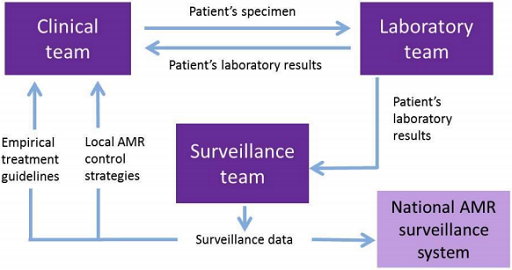4.1 Local surveillance systems in practice: patient care and surveillance
Laboratory teams working in microbiology laboratories regularly perform bacterial identification and antimicrobial susceptibility tests on samples collected by the clinical team (nurses, doctors, veterinarians) or animal owners, to provide information that can be used to treat the patient (human or animal). However, in many low and middle-income settings, bacterial identification and antimicrobial susceptibility testing (AST) are rarely performed due to financial, technical and logistical limitations.
To try to improve clinical care, laboratory capacity and AMR surveillance, a small number of laboratories may be specially supported in their microbiology capacity. Information obtained for clinical care can be collated and used as (passive) surveillance data, analysed and reported on by local surveillance teams and finally fed into a national AMR surveillance system, as detailed in Figure 6.

Figure 6 The relationship between patient care and surveillance (WHO, 2020).
Show description|Hide descriptionA flow chart. There is a box labelled ‘Clinical team’ that has an arrow, labelled ‘Patient’s specimen’, pointing to another box, labelled ‘Laboratory team’. Another arrow, labelled ‘Patient’s laboratory results’, points from this box back to to ‘Clinical team’. A second arrow from ‘Laboratory team’, also labelled ‘Patient’s laboratory results’, points to another box, ‘Surveillance team’. There’s an arrow from this box that points to a label, ‘Surveillance data’. Surveillance data has three arrows; one points to a new box, ‘National AMR surveillance system’; the other two, labelled ‘Empirical treatment guidelines’ and ‘Local AMR control strategies’, point back to ‘Clinical team’.
Now that you have looked at some aspects of local surveillance it is time to think about how this applies to your work by completing Activity 3.
Activity 3: the AMR surveillance process in your workplace
Timing: Allow about 45 minutes
By signing in and enrolling on this course you can view and complete all activities within the course, track your progress in My OpenLearn Create. and when you have completed a course, you can download and print a free Statement of Participation - which you can use to demonstrate your learning.
Part 2
Figure 7 is an example of a local surveillance system.

Figure 7 The relationship between patient care and surveillance (WHO, 2020).
Show description|Hide descriptionA flow chart. There is a box labelled ‘Clinical team’ that has an arrow, labelled ‘Patient’s specimen’, pointing to another box, labelled ‘Laboratory team’. Another arrow, labelled ‘Patient’s laboratory results’, points from this box back to to ‘Clinical team’. A second arrow from ‘Laboratory team’, also labelled ‘Patient’s laboratory results’, points to another box, ‘Surveillance team’. There’s an arrow from this box that points to a label, ‘Surveillance data’. Surveillance data has three arrows; one points to a new box, ‘National AMR surveillance system’; the other two, labelled ‘Empirical treatment guidelines’ and ‘Local AMR control strategies’, point back to ‘Clinical team’.
Try to match each example action/activity listed below to the aspect of local surveillance (included on the figure) that it most closely relates to.
Receiving a sample and the action of performing identification and a susceptibility testing according to standard methods
A team responsible for data collection gives a report to a hospital committee about the use of antibiotics in the hospital
A patient with a suspected infection is seen and an appropriate sample is taken for further investigation
Data are formatted and standardised according to set guidelines for submission
National surveillance system
A team collates and analyses data to guide public health policy on AMR
Using the following two lists, match each numbered item with the correct letter.
Laboratory team
Surveillance team
Clinical team
Surveillance data
National surveillance system
a.A team collates and analyses data to guide public health policy on AMR
b.Receiving a sample and the action of performing identification and a susceptibility testing according to standard methods
c.Data are formatted and standardised according to set guidelines for submission
d.A patient with a suspected infection is seen and an appropriate sample is taken for further investigation
e.A team responsible for data collection gives a report to a hospital committee about the use of antibiotics in the hospital
The correct answers are:
- 1 = b
- 2 = e
- 3 = d
- 4 = c
- 5 = a




